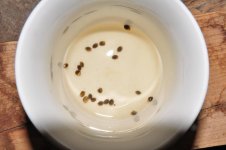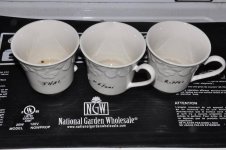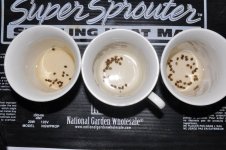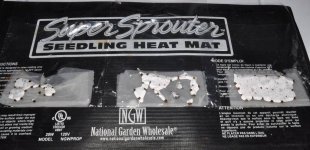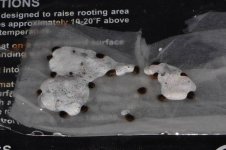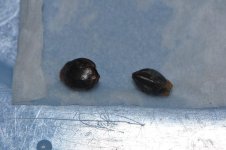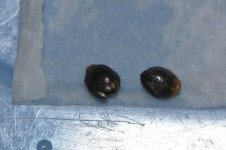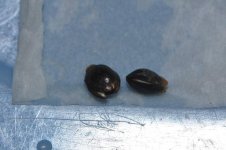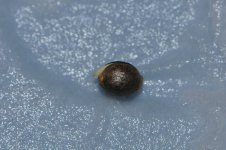-
Happy Birthday ICMag! Been 20 years since Gypsy Nirvana created the forum! We are celebrating with a 4/20 Giveaway and by launching a new Patreon tier called "420club". You can read more here.
-
Important notice: ICMag's T.O.U. has been updated. Please review it here. For your convenience, it is also available in the main forum menu, under 'Quick Links"!
You are using an out of date browser. It may not display this or other websites correctly.
You should upgrade or use an alternative browser.
You should upgrade or use an alternative browser.
Chocolate Thai Revival
- Thread starter Zanddar
- Start date
Not exactly... it was a vitamin B and because it's water soluble it was attributed to the B family until they figured out that humans don't really need it. Vitamins are basically organic molecules humans need but can't build by themselves. They have often not much in common with essential stuff in other species other than having a limited boisynthesis, supplementing them can be beneficial even if they aren't real vitamins in for example plants. It's maybe a coincidence or laziness of mother nature that animals and plants use the same co-factors for different enzymes and that several of the B vitamins and ex-vitamins are quite helpful for example for rooting, vitality, or stress management in plants. So far, I've seen very nice effects on young plants. Flowering ones... I'm not sure cause I was a bit too mad a scientist and tested all at once@ ornamental: I never knew cholines were vitamin b analogues. Interesting. Also interesting that you seem to have literal experience feeding your plants with it. Hahaa, couldn't resist that last bit. Cheers!
I use a very cheap vitamin B pills for humans (cheap = usually no unwanted additives, but thoroughly check first) which contains also some non-essential things for plants but these fortunately have no negative effects either. Just make sure that the preparation doesn't contain micro-nutrients and trace elements as they will likely be 10 t0 100 times too concentrated. Most of all zinc and copper, which may even kill seedlings; I tired such a product and the lil ones weren't that happy with it, adult plants haven't shown any side effects after two or three applications but that's as expected in soil.
Personally, I'm not such a fan of brown sugar for 'surgical' procedures because of its high content in trace elements (I mean, I love the taste and all and it's certainly healthier). Most of all iron, which facilitates microbial growth (it literally boosts them exponentially) and as I tend to forget changing the seed soak solution daily... Anyway, inorganic nutrients shouldn't be too much of a problem for old seeds because they don't spoil as easily. Vitamins and energy metabolites ('carbs') on the other hand have a relative short shelf life... That's just my personal opinion and others may have better experience or feel more comfortable with different products. Got to try it for yourself
Not exactly... it was a vitamin B and because it's water soluble it was attributed to the B family until they figured out that humans don't really need it. Vitamins are basically organic molecules humans need but can't build by themselves. They have often not much in common with essential stuff in other species other than having a limited boisynthesis, supplementing them can be beneficial even if they aren't real vitamins in for example plants. It's maybe a coincidence or laziness of mother nature that animals and plants use the same co-factors for different enzymes and that several of the B vitamins and ex-vitamins are quite helpful for example for rooting, vitality, or stress management in plants. So far, I've seen very nice effects on young plants. Flowering ones... I'm not sure cause I was a bit too mad a scientist and tested all at once. But the effect was positive.
I use a very cheap vitamin B pills for humans (cheap = usually no unwanted additives, but thoroughly check first) which contains also some non-essential things for plants but these fortunately have no negative effects either. Just make sure that the preparation doesn't contain micro-nutrients and trace elements as they will likely be 10 t0 100 times too concentrated. Most of all zinc and copper, which may even kill seedlings; I tired such a product and the lil ones weren't that happy with it, adult plants haven't shown any side effects after two or three applications but that's as expected in soil.
Personally, I'm not such a fan of brown sugar for 'surgical' procedures because of its high content in trace elements (I mean, I love the taste and all and it's certainly healthier). Most of all iron, which facilitates microbial growth (it literally boosts them exponentially) and as I tend to forget changing the seed soak solution daily... Anyway, inorganic nutrients shouldn't be too much of a problem for old seeds because they don't spoil as easily. Vitamins and energy metabolites ('carbs') on the other hand have a relative short shelf life... That's just my personal opinion and others may have better experience or feel more comfortable with different products. Got to try it for yourself.
Any thoughts on the use of un-sulfered molasses OO?
For such an adventure and in a hopefully microbe-reduced environment, I wouldn't use molasses for several reasons:Any thoughts on the use of un-sulfered molasses OO?
- Not well defined to even unknown composition
- Wide variation between type of molasses, manufacturing process, product/brand and even between batches (after all, it's a by-product)
- Contains oligosaccharides which are unavailable to seeds/seedlings
- Contains proteins but most of all high amounts of non-protein nitrogen which are mostly good for micro-organisms but potentially harmful for seedling development
- Contains high amounts of minerals: A 1% solution as may be employed in seedling growth media contains dangerously high amounts, under others also sodium chloride leading to salt stress and stunting growth further
- The main desired effects of sugars on seedling growth are elicited by glucose and sucrose
- Adding unknown amounts of unknown stuff makes things unpredictable and less repeatable
-> Molasses should not be used at 1%, maybe not even at 0.1% on valuable seeds or weak seedlings. Lower concentrations may work to a degree but will not have the full action spectrum (the one I would want). Besides, it gives a mess when applied to a proper environment such as seedlings on a towel which has to be renewed daily. Use it in dirt on healthy plants, that's fine
interesting thread and i'll be following along. i'm in the midst of trying to pop some similarly aged seeds. i got one to pop a few years ago my "Circa94" male. i tried at least 100 or close to it seeds, and i get to the same stage as you. seed shell opens on some of em. and then nothing else. i'm going to try again with superthrive, one with h202 , and one with the "seed water" which i understand should contain giberrelins. after that i'm gonna try coconut water, rice water i'm gonna make, the cold shock, and it that doesn't work i'm going to try aloe water.
i'll be trying some of the suggestions here that i haven't tried. good luck. and i'll be sure to let you know if i find anything that works.
i'll be trying some of the suggestions here that i haven't tried. good luck. and i'll be sure to let you know if i find anything that works.
Hello and thx for all the info everyone.
Pulled a few from the fridge today and scuffed them.
Some seed crumbled in my fingers as I scuffed them, because they were dried out and others are still viable.
They are soaking in RO water, few grains of sugar and few drops of grozyme.
Have some other things to try yet and we see how this works.
Also have some GA3 on the way and see how that works later if needed.
Special needs require special care and have to try whatever I can to get them to go.
Pulled a few from the fridge today and scuffed them.
Some seed crumbled in my fingers as I scuffed them, because they were dried out and others are still viable.
They are soaking in RO water, few grains of sugar and few drops of grozyme.
Have some other things to try yet and we see how this works.
Also have some GA3 on the way and see how that works later if needed.
Special needs require special care and have to try whatever I can to get them to go.
Attachments
Soaked in sugar water and grozyme for 6 hours until sunk.
Placed into bags with sugar water and we see what grows tails.
Also have some Northern Flame and Ripper seed from 5 years ago as a side test.
The N. Flame has cracked and germed after only 6 hrs soak.
Stay Tuned
Placed into bags with sugar water and we see what grows tails.
Also have some Northern Flame and Ripper seed from 5 years ago as a side test.
The N. Flame has cracked and germed after only 6 hrs soak.
Stay Tuned
Attachments
B
bringyalungs
come on baby, make it... we need you to.... don't die on us... not like this.... not like this...
Heusinomics
Active member
I came across this reposted by DankFrank in another thread on sprouting old seeds and thought it could b of use here...
This is ClackmasCoots seed soak recipe for old seeds:
12 oz. pure coconut water
1 oz. BioAg Ful-Power (pure Fulvic acid)
1 oz. Aloe vera juice
Fill to 1 gallon with the cleanest, purest water you can get your hands on. Soak your seeds for 24 - 36 hours and then strain.
Best of luck n happy growing!
This is ClackmasCoots seed soak recipe for old seeds:
12 oz. pure coconut water
1 oz. BioAg Ful-Power (pure Fulvic acid)
1 oz. Aloe vera juice
Fill to 1 gallon with the cleanest, purest water you can get your hands on. Soak your seeds for 24 - 36 hours and then strain.
Best of luck n happy growing!
come on baby, make it... we need you to.... don't die on us... not like this.... not like this...
Stimulates Metabolism
Fulvic acid appears to cause the genetic mechanism of plants to function at a higher level. It has been concluded that when plant cells are exposed to fulvic acid it can improve growth.
Oxygen is absorbed more intensely in the presence of fulvic acids.
Fulvic acid aids in penetrating plant roots, relieves oxygen deficiency, increases the vital activity of cells and changes the pattern of the metabolism of carbohydrates, resulting in an accumulation of soluble sugars.
These soluble sugars increase the pressure of osmosis inside the cell walls and enable plants to withstand wilting, which enhances growth stimulation to the immune system.
Not to mention that sugar production is a main function of fertilizer processing and is therefore direct energy for plants.
Will p/u some today and a coconut for something to drink.
^ current seed preservation run on some old "elvis" seeds.
i've done close to 20 attempts on preserving beans from old seed stock. i bought out all of fritzman's ( defunct bsc) stock and paid extra to get at least 20# of each strain. i've done other strain preservation attempts as well.
the above picture is pretty good at depicting healthy white emergining from old seed stock.
hit "control + '+' " at the same time to pump up magnification on above pic. for better view.
in my experience, without some special technique of which i am still unaware, only one or two of these healthy looking specimens will actually manifest a root tail.
there are a lot of posts on germing old seedstock. tons of different ideas. i have not run across one poster who actually pictorially depicts old seed stock showing white, yet no root tail emerging like above photo and pictorially shows how to get these to actually sprout a tail.
i use distilled water in paper towels. i change the towel after a few days. 65-75 degree f temps. i get 100 % germ. rates usually on viable seed stock using this simple technique most of the time. tail emerges immediately, unlike the (unfurling, showing white, no tails) pic. posted above.
One CT has a radicle and another has germed in 24 hrs.
Some CT have a brown skin on the radicle when it emerges.
Most JTR have germed and have a normal white radicle.
Moved the heat pad to an insulated area and as the temp went up many started to germ faster.
Have to get a thermometer and see what the temp is. Must be near 80 now.
Some CT have a brown skin on the radicle when it emerges.
Most JTR have germed and have a normal white radicle.
Moved the heat pad to an insulated area and as the temp went up many started to germ faster.
Have to get a thermometer and see what the temp is. Must be near 80 now.
Attachments
Zanddar, Sweet! I hope you fine great things! Maybe start some right in your soil mix might help! Warm is good too! I was getting bad seed germ rates until I started putting them outside in dirt and sunshine in my raised beds! Worked great! Just a thought! I hope it helps you bring these back! monkey5
The added heat has had a positive effect on the other strains, but CT is still not doing much.
Some will push out a radicle and not grow further. In RO sugar water, fulvic acid and grozyme.
Also some in soil with another heat mat. Will keep trying different things and hope to find what works for these.
Some will push out a radicle and not grow further. In RO sugar water, fulvic acid and grozyme.
Also some in soil with another heat mat. Will keep trying different things and hope to find what works for these.
@Zanddar
Which concentration of sugar do you use?
Do you have access to cytokinins (BAP)?
Which concentration of sugar do you use?
Do you have access to cytokinins (BAP)?
I don't know if someone already said it here, but i heard Hydrogen peroxide is quite efficient beside the GA3 method, it will kill all bacteria & ad oxygen to help germination. i'm not 100% sure of it but you may flush the seeds after soaking em in the H2O2..
Hope you will find some help to get them viable..
Peace
Hope you will find some help to get them viable..
Peace
Try at least 0.1% (1'000 ppm), maybe even 10 times more! A little sugar is likely good but only provides some food but will not trigger a 'sugar response'. It's the latter you want though the former is a welcome 'side effect'. I don't believe (don't know for sure either) that your pinch in a glass of water will motivate the embryos to grow.Just put a pinch of white sugar in half inch glass of RO water. Could see the sugar dissolved and the other strains were ok with the mix.
Have to go back to the store today and see if they have that.
Yes, we had that... several times, actually.I don't know if someone already said it here, but i heard Hydrogen peroxide is quite efficient beside the GA3 method, it will kill all bacteria & ad oxygen to help germination. i'm not 100% sure of it but you may flush the seeds after soaking em in the H2O2...
It will only kill efficiently at 3% or higher (should only be used on intact seeds for a few minutes!) whereas it's direct biological effect is at about 0.06% (H2O2 is a second messenger, a signalling molecule). This difference in concentration is an advantage insofar as 'sterilised' seeds may only be dried quickly with a towel without rinsing prior to putting them in plain water or whatever; the remaining hydrogen peroxide in the shell should suffice to trigger a germination response. On the other hand, providing oxygen is IMHO probably only useful in DWC, if ever. And again, the issue is not germination aka breaking seed dormancy but absence of growth after this event. And there, hydrogen peroxide plays only a minor role and is highly contra-productive at concentrations well above those 0.06%.

